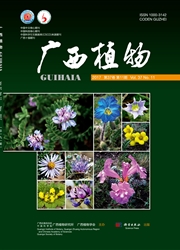

 中文摘要:
中文摘要:
该文对广西桂林灵田乡桉树、针叶树和阔叶树生理生化季节变化进行了比较研究。结果表明:桉树与其它4个针阔叶树种的生理生化指标因季节更替而呈现不同的变化规律,其中5个树种叶片的比叶面积是在夏季最高、冬季最低,其均值依次为桉树〉红锥〉黧蒴栲〉杉木〉马尾松;叶片叶绿素含量为夏季〉秋季〉春季〉冬季,总叶绿素含量四季平均值为桉树〉黧蒴栲〉红锥〉杉木〉马尾松;叶片可溶性糖含量的季节变化为夏季〉春季〉冬季〉秋季,桉树的平均可溶性糖最高;叶片蛋白质含量都在春季最高、夏季最低,阔叶树种的蛋白质含量显著高于针叶树种,桉树的平均蛋白质含量最高;叶片硝酸还原酶活性顺序为夏季〉春季〉秋季〉冬季,桉树的平均硝酸还原酶活性最高。综上所述,在自然生长环境下,这5个树种的生理生化等指标对季节的响应机制不同,但桉树的生理指标大于其他几个树种。这反映了人工种植的桉树具有高生产力和生长优势。
 英文摘要:
英文摘要:
The seasonal changes in physiological and biochemical characteristics of Eucalyptus,coniferous and broadleaved tree species were studied at Lingtian Village of Guilin City,Guangxi Zhuang Autonomous Region. The results showed that the physiological and biochemical norms changed according to seasons in Eucalyptus and other four tree species. The SLA of five species was the highest in the summer and lowest in winter. The average SLA values were Eucalyptus 〉Castanopsis hystrix〉 C. fissa 〉Cunninghamia lanceolata 〉Pinus massoniana. Leaf chlorophyll of seasonal changes was as follows: summer 〉autumn 〉spring 〉winter. The average of total chlorophyll in four seasons were: Eucalyptus 〉Castanopsis fissa〉 C. hystrix 〉Cunninghamia lanceolata〉 Pinus massoniana. The SS with seasonal changes were: sum-mer 〉spring 〉winter 〉autumn; the SP contents of the five species were the highest in spring and the lowest in summer,and the SP in coniferous were much higher than the broad-leaved species. The average SS and SP were the highest in Eucalyptus. Seasonal trends showed arched leaf RNA variation,the order of change was summer〉 spring 〉autumn 〉winter,with average maximum NRA in Eucalyptus. To sum up,in a natural environment for the growth,physiological and biochemical indices of these five species response to season were different,but the physiological indicators of Eucalyptus were generally higher than other species,which inflected that the artificial Eucalyptus forest had high productivity and growth advantage.
 同期刊论文项目
同期刊论文项目
 同项目期刊论文
同项目期刊论文
 AssessingStructureStatein Successional Stages of Dark Coniferous Forests in Western Sichuan,China (F
AssessingStructureStatein Successional Stages of Dark Coniferous Forests in Western Sichuan,China (F 期刊信息
期刊信息
